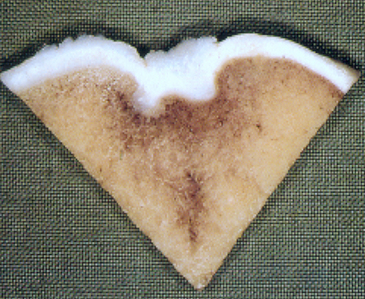CHAPTER 114 Osteochondrosis
Osteochondrosis is one of the most important joint diseases affecting young growing horses. The reported incidence varies, but there seems to be a trend toward an increase over the past few decades. Early work reports an incidence of 10% to 15%, but more recent publications mention figures up to 32%. All major studbooks and breeders regard the disease as a substantial problem. The mean incidence is estimated at 25%, and in northwestern Europe alone, 25,000 foals annually develop osteochondrosis. The impact of osteochondrosis on the equine industry, both in terms of economic loss and in impairment of animal welfare, cannot be overemphasized.
PATHOGENESIS
The classic hypothesis of equine OC is that there is disturbance of the physiologic process of endochondral ossification that leads to locally thickened cartilage plugs (Figure 114-1). At the same time, cartilage canals disappear in a physiologic process called chondrification. From that moment, nutrition of the articular cartilage depends exclusively on diffusion of nutrients from the synovial fluid. Excessive thickening of the cartilage layer leads to malnutrition of certain areas and hence to focal necrosis and weakening of the tissue. Together with biomechanical influences, this may result in the formation of fissures, cartilage flaps, and eventually loose fragments or joint mice.

Figure 114-1 Section of bone taken through the articular-epiphyseal cartilage complex revealing thickened retained cartilage.
(Courtesy PR van Weeren, Utrecht University)
This hypothesis seems straightforward, but many concerns, including the fact that thickened cartilage or necrosis is not always seen with typical OC lesions, have been expressed that call into question the accuracy of the single hypothesis for OC. Recent investigations of the molecular mechanisms of OC indicate that the collagen component of the cartilage extracellular matrix is primarily affected. It is hypothesized that a defective collagen network results in disturbed calcification of cartilage, as has been shown in bone, causing delayed endochondral ossification, which is the hallmark of OC. Furthermore, a defective collagen network likely reduces the tensile strength of the cartilage and may, together with or without local cartilage thickening and biomechanical forces, result in the development of characteristic cartilage flaps or fragments. Osteochondrosis is a complex disease of multifactorial origin, and how these factors interrelate to produce the disease remains poorly understood.
Stay updated, free articles. Join our Telegram channel

Full access? Get Clinical Tree


